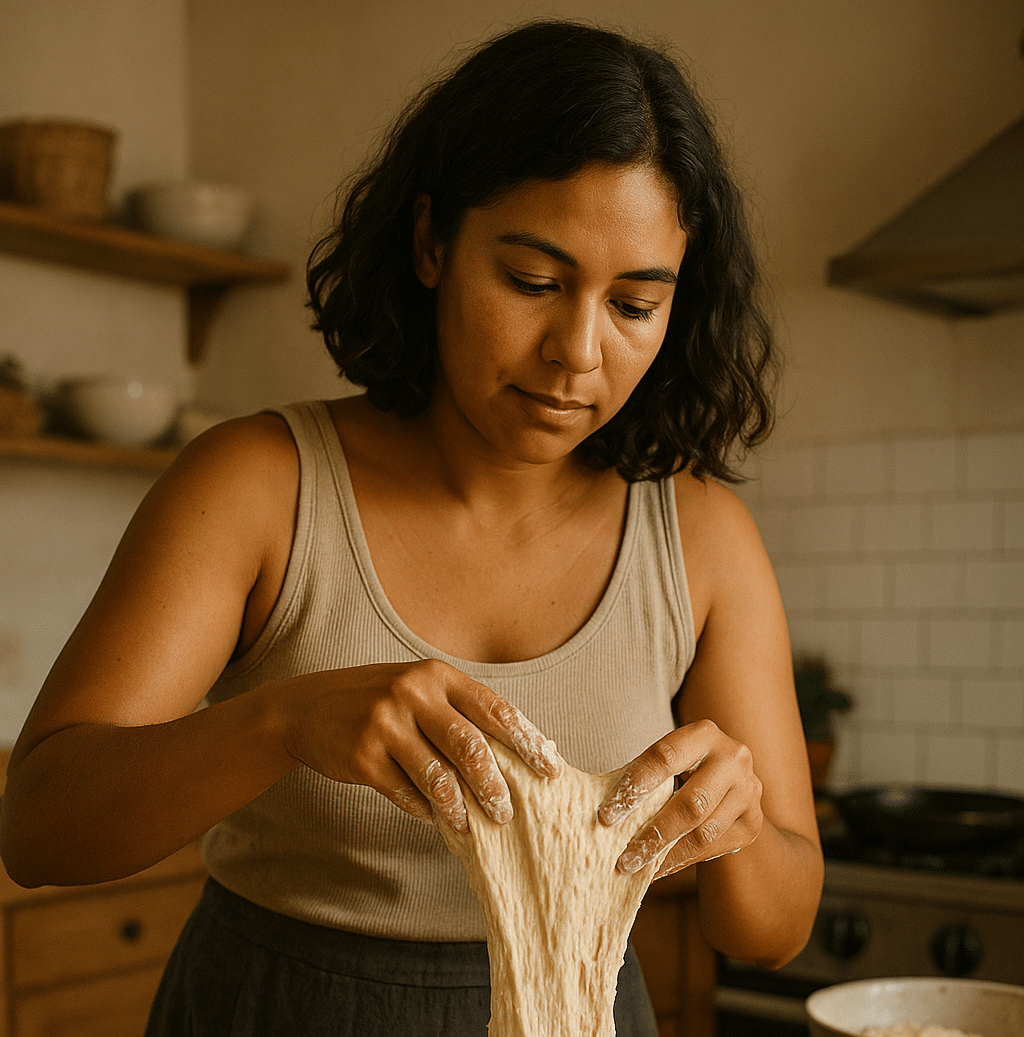Welcome to your new favorite bake: the sourdough pretzel bread recipe that brings together the tang of sourdough and the chewy satisfaction of pretzels. In this guide, I’ll walk you through exactly how to make it—no guesswork, no over-proofed dough. Whether you’re crafting it for burgers, dipping into beer cheese, or enjoying plain with butter, this recipe delivers bold flavor and a perfect crust. We’ll dive into what sets pretzel bread apart, how to achieve that signature pretzel taste, and how to store or freeze your bakes so they stay fresh. Let’s get into it.
Table of Contents
Sourdough Meets Pretzel – A Homemade Story Worth Telling
There’s a certain kind of magic in baking sourdough. It’s slow, wild, and just a little bit rebellious. I remember the first time I tested a sourdough pretzel bread recipe—on a rainy Saturday afternoon, flour-dusted and hopeful. I’d fed my starter the night before and could tell it was ready. As I dropped the shaped dough into the baking soda bath, I watched them swell and float. The smell that filled the kitchen was rich, yeasty, and nostalgic. What came out? Golden, shiny rolls with a tangy chew and crackling crust. It was everything I didn’t know I needed.
The beauty of this sourdough pretzel bread recipe is how it blends two traditions: the complexity of natural fermentation and the iconic chew of a soft pretzel. If you’ve made sourdough before, this is a fun twist. If this is your first bake, welcome—this recipe is a great place to begin. The crust bakes deep golden and slightly glossy, and the inside stays tender but satisfying.
So what makes pretzel bread truly different from regular bread? First, the alkaline water bath. Before baking, each roll is boiled in a baking soda solution. This step is essential—it creates that signature chewy crust and rich color. Second, the flavor. A proper sourdough pretzel bread recipe results in a deep, malty taste with subtle sweetness. Third, the dense crumb structure makes it ideal for burgers, sandwiches, or simply torn warm from the oven.
If you enjoy my classic sourdough sandwich loaf, this version adds bold flavor and texture. It’s more than just bread—it’s a celebration of fermentation and comfort in every bite. Once you’ve tried this sourdough pretzel bread recipe, it’s sure to become a favorite in your rotation.
From Starter to Boil – Your Pretzel Dough Blueprint
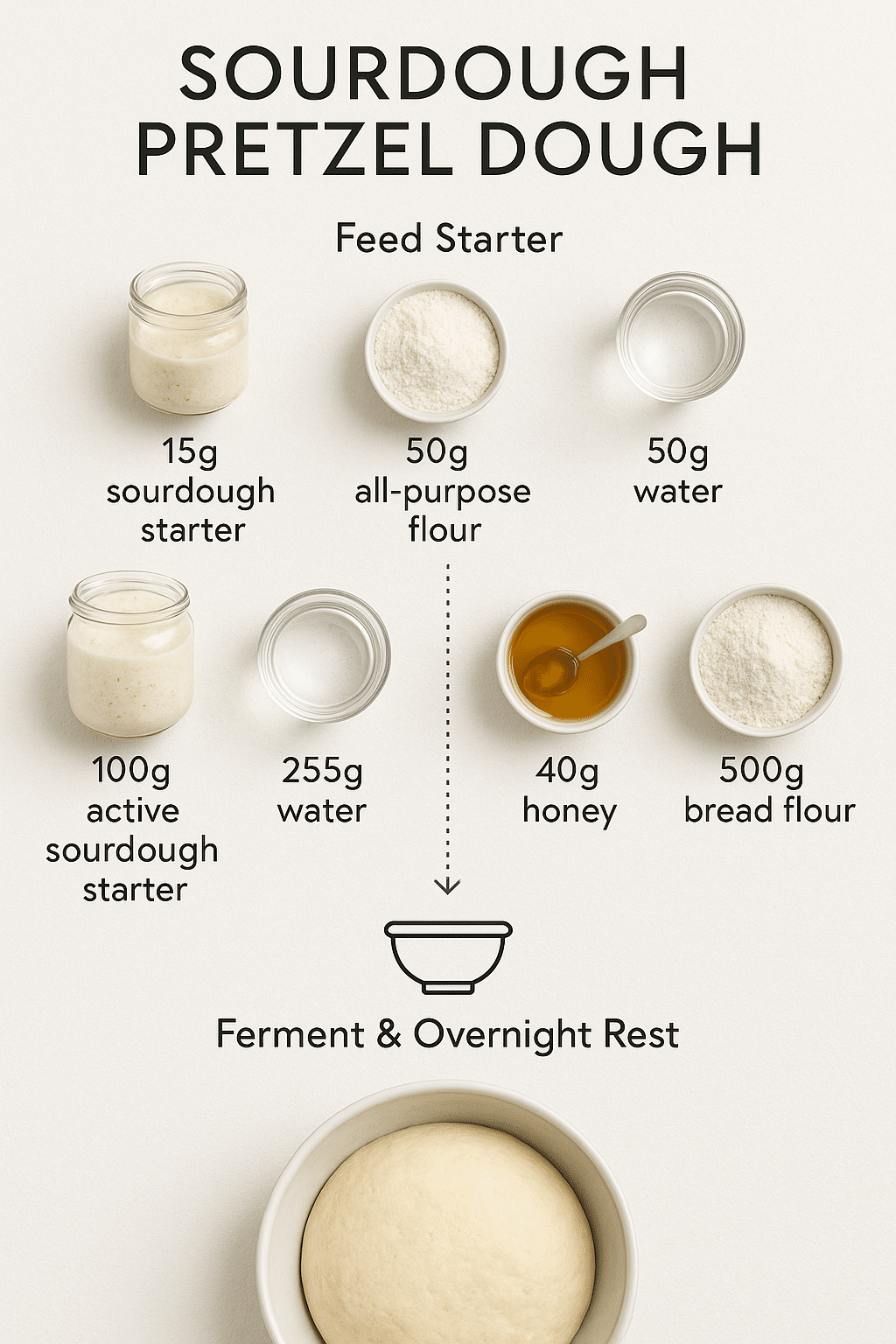
Every good sourdough pretzel bread recipe starts with a strong foundation: a healthy, active sourdough starter. Make sure it’s bubbly and recently fed. If you’re unsure, you can learn how to build yours up with my guide to strengthening your sourdough starter. Once your starter’s ready, you’re just a few steps away from rich, chewy perfection.
In a large mixing bowl or stand mixer, combine:
- ½ cup (100 g) active sourdough starter
- 1 cup plus 1 tablespoon (255 g) water
- 2 tablespoons (40 g) honey (or sugar if preferred)
- 2 teaspoons (10 g) fine sea salt
- 4 cups + 2 tablespoons (500 g) bread flour
This dough is intentionally low hydration, so don’t expect the stretchiness of a typical high-hydration loaf. Instead, it will feel dense and slightly stiff. If kneading by hand, be patient—it’ll take a bit of muscle. Using a stand mixer with a dough hook will make the job easier and give you a smoother finish. Knead for about 10 minutes until the dough becomes soft, smooth, and no longer sticky.
Cover the bowl with a damp towel or plastic wrap and let the dough rise at room temperature. It won’t double like traditional sourdough, but it should puff up by about 50%. This bulk fermentation can take several hours—sourdough moves slowly, especially in stiffer doughs. If your kitchen is cool, consider a warm proofing spot like an oven with the light on.
This step is the heart of the sourdough pretzel bread recipe. A strong rise gives the final rolls structure and depth of flavor. For a visual timeline, visit my bulk fermentation troubleshooting guide. Once you’ve nailed this stage, the next steps—shaping and boiling—become a breeze.
Boiling and Baking – Creating That Classic Pretzel Crust
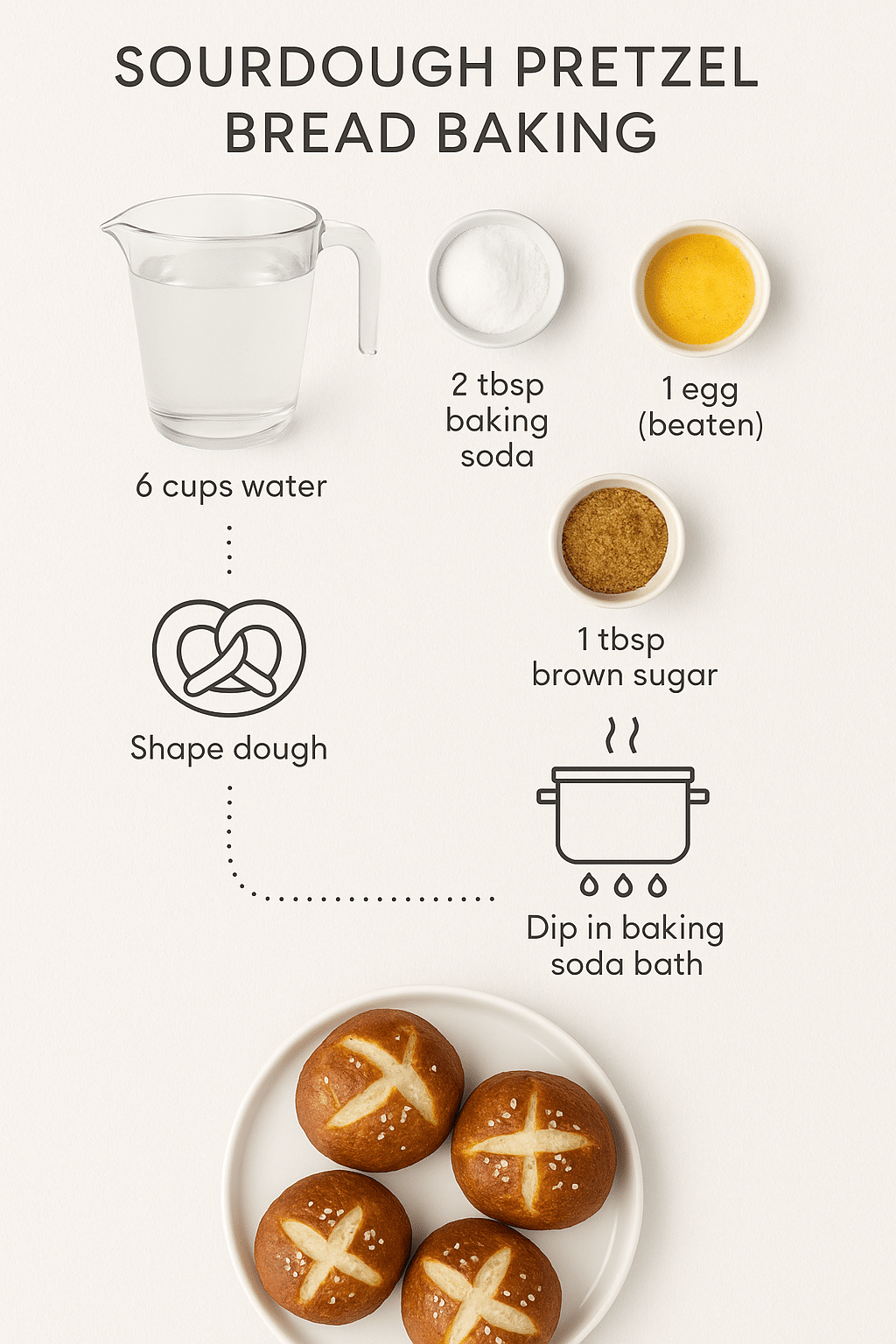
This is where your sourdough pretzel bread recipe becomes unmistakably “pretzel.” Once the dough is shaped and risen, it takes a quick dip in a baking soda bath—a technique that sets it apart from any standard roll.
Divide the dough into even portions, about 80 grams each for rolls. Shape each into a tight round ball using a simple tuck-and-pinch method, building tension for an ideal rise. Let the dough rest until slightly puffy, then place the tray in the freezer for 10–15 minutes. This brief chill helps the buns hold their shape during boiling.
Next, prepare the bath:
- 6 cups water
- 2 tablespoons baking soda
- 1 tablespoon dark brown sugar
Bring this to a light boil. Carefully lower 2–3 rolls into the bath at a time. Boil for 30 seconds—once they float, they’re ready. This boiling step is what gives the pretzel bread its rich flavor and glossy crust. Without it, even the best dough won’t develop that signature texture.
After boiling, transfer each bun to a parchment-lined baking sheet. Brush with egg wash and sprinkle with coarse salt. Use a sharp knife to score a small cross on top. This will let the buns open beautifully in the oven.
Bake at 390°F (200°C) for 15 to 20 minutes until deep golden brown. This is the final transformation of your sourdough pretzel bread recipe—a crisp crust, a soft chew, and a visual you can’t resist.
Want more tips on how to get that signature finish? Don’t miss our guide to sourdough scoring techniques, perfect for this bake.
Serving, Storing, and Pairing – Make the Most of Every Roll
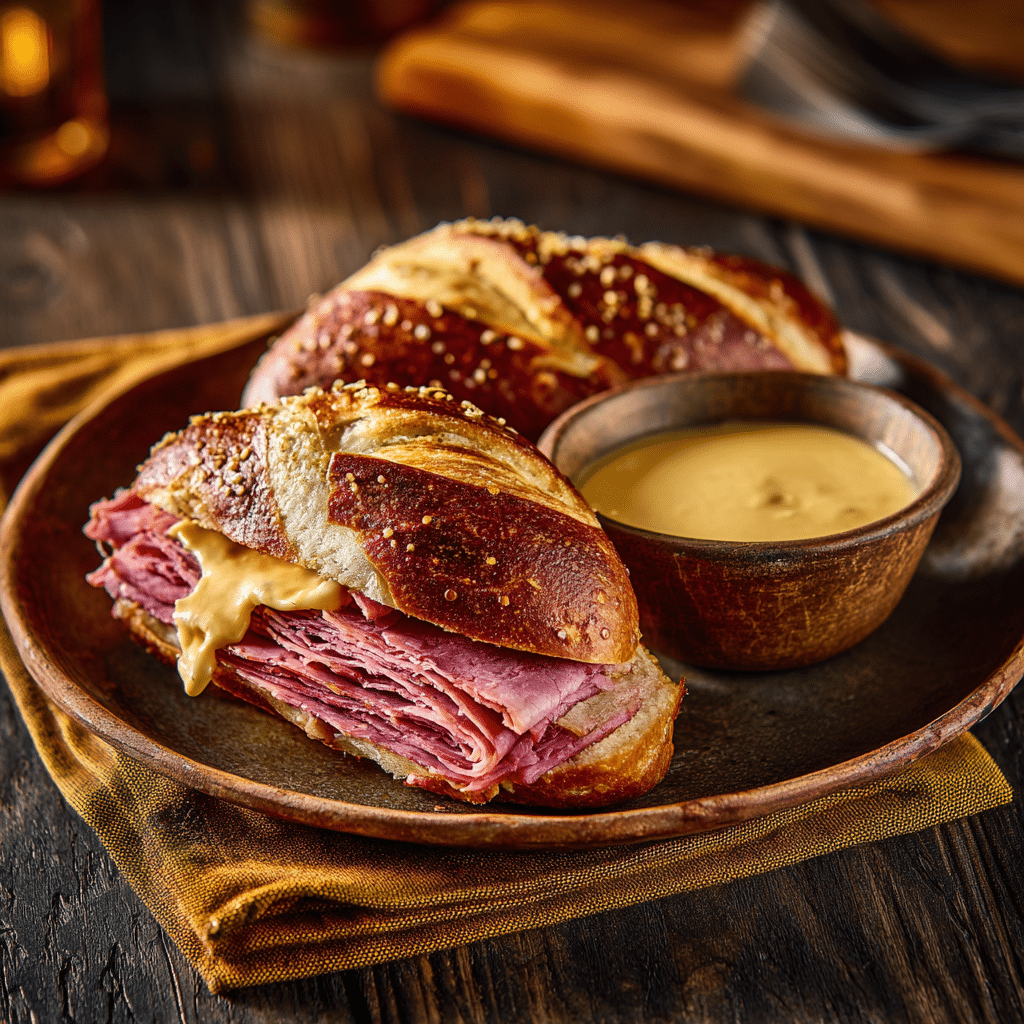
Once your sourdough pretzel bread recipe has delivered those golden, aromatic rolls fresh from the oven, you may be wondering: how do I keep them at their best? And how should I serve them?
Storing: Pretzel bread is best the day it’s baked. That crackling crust and chewy interior are at their peak within the first 12 hours. If you’re not eating them all at once, store in an airtight bag or container at room temperature. Avoid refrigeration—it dries them out quickly.
Freezing: These rolls freeze exceptionally well. Allow them to cool fully, then place them on a tray to “flash freeze” (about 30 minutes). Once solid, move to a sealed zip-top bag or freezer-safe container. They’ll keep for up to 2 months. When ready to eat, thaw at room temperature, then warm gently in a 325°F oven for 5–7 minutes to revive the crust. For more help, check out my full guide to freezing sourdough.
Pairing: What goes well on pretzel buns? Pretty much anything with bold, salty, or creamy flavors. These buns stand up to serious fillings:
- Juicy cheeseburgers with spicy mustard
- Sharp cheddar and caramelized onions
- Pastrami, kraut, and Swiss for a Reuben-style twist
- Bacon, egg, and avocado for a breakfast sandwich
They’re also fantastic sliced and dipped into mustard, melted cheese, or even soup. If you’re feeling adventurous, try them with homemade sourdough mustard—the flavors were meant to be together.
The beauty of this sourdough pretzel bread recipe is its versatility. It’s just as happy on a dinner plate as it is in a picnic basket. Once you’ve baked a batch, you’ll always want a few in your freezer—just in case.
Print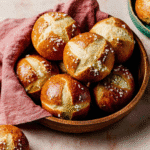
Sourdough Pretzel Bread Recipe: 5-Step Flavor Boost
- Total Time: 6 hours 20 minutes
- Yield: 8–10 rolls
Description
A rich, chewy sourdough pretzel bread recipe with a golden crust and hearty crumb. Great for sandwiches, burgers, or dipping.
Ingredients
For Starter (makes 100g):
- 1 tbsp (15g) sourdough starter
- 1/3 cup + 1 tbsp (50g) all-purpose flour
- 3 1/2 tbsp (50g) water
Dough:
- 1/2 cup (100g) active sourdough starter
- 1 cup + 1 tbsp (255g) water
- 2 tbsp (40g) honey or sugar
- 2 tsp (10g) fine sea salt
- 4 cups + 2 tbsp (500g) bread flour
Water Bath:
- 6 cups water
- 2 tbsp baking soda
- 1 tbsp dark brown sugar
Egg Wash:
- 1 egg, beaten
- 1 tbsp coarse salt
Instructions
Make the starter 6–8 hours before baking.
Combine dough ingredients and knead 10 minutes until smooth.
Let rise 4–6 hours at room temp until puffy.
Shape into balls and rest 30 minutes, then chill in freezer 10–15 minutes.
Boil each in baking soda water for 30 seconds, remove and score tops.
Brush with egg wash and salt. Bake at 390°F for 15–20 minutes.
Cool before serving or freezing.
Notes
To freeze: cool completely, flash freeze, and store up to 2 months.
Reheat from frozen at 325°F for 5–7 minutes.
- Prep Time: 6 hours (with fermentation)
- Cook Time: 20 minutes
- Category: Bread
- Method: Baking
- Cuisine: American, German
Frequently Asked Questions
What makes pretzel bread different from regular bread?
Pretzel bread is boiled in an alkaline solution—typically water and baking soda—before baking. This unique step creates a chewy texture and a shiny, golden crust that regular bread doesn’t have. It also gives pretzel bread a distinct, slightly bitter flavor that balances beautifully with salt and richness.
What makes a pretzel bun taste like a pretzel?
The baking soda bath is the secret. By briefly boiling the dough before baking, the surface of the bun undergoes a Maillard reaction, which creates that deep brown crust and unmistakable pretzel flavor. Without the bath, the dough would bake like any regular bread.
How to store and freeze?
Store your pretzel rolls at room temperature in an airtight bag for up to 12 hours. To freeze, cool completely, flash-freeze for 30 minutes, and store in a sealed container or ziplock bag. Reheat in the oven at 325°F for 5–7 minutes to restore the crust.
What goes well on pretzel buns?
Bold, savory fillings are ideal: grilled meats, cheese, eggs, mustard, and even roasted vegetables. The sturdy texture makes them perfect for burgers, sandwiches, or paired with soup. They also shine with mustard or beer cheese dips.
Conclusion
This sourdough pretzel bread recipe is more than a baking project—it’s a delicious meeting point of fermentation and tradition. From the crackle of the crust to the tangy chew of sourdough, each bite is a small victory. Whether you serve them fresh, freeze a batch, or layer them with your favorite fillings, these buns will become a regular part of your baking rhythm.
If you’ve ever wondered whether your sourdough starter was ready for something bold, this is it. Give this recipe a try, and you’ll soon find yourself returning to it—again and again.


